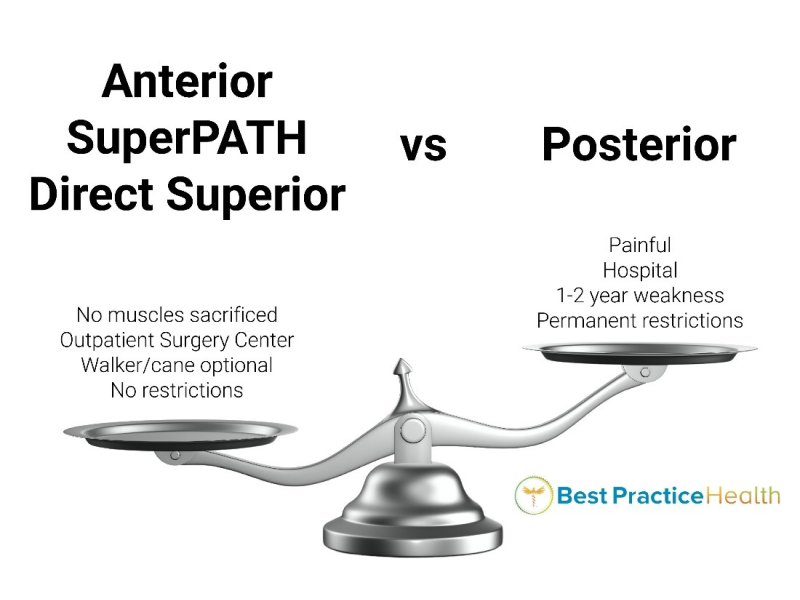
Can I go back to my normal activities like soccer after total hip replacement (THR) surgery?
Can I go back to my normal activities like soccer after total hip replacement (THR) surgery? https://bestpracticehealth.tv/wp-content/uploads/2023/09/activities-banner-1-1024x285.png 1024 285 Best Practice Health TV Best Practice Health TV https://bestpracticehealth.tv/wp-content/uploads/2023/09/activities-banner-1-1024x285.pngA: It depends on the surgical approach. If your surgeon was Best Practice Certified, then in a word… yes.
No matter how good your surgeon is, everyone must go through the post-operative period and rehabilitation before they are ready to return to normal activities like sports. At that point, there is a big fork in the road, depending on the approach your surgeon used.

During THR an orthopedic surgeon replaces your hip joint with a new one. There are four different surgical approaches orthopedic surgeons commonly use. Until ten years ago nearly all orthopedic surgeons used the posterior approach, which literally means from behind.
The posterior approach requires the orthopedic surgeon to strip down the muscles and capsule covering the hip joint. Recovery from a posterior approach to THR can take years. You will be sent to a physical therapist for months after surgery to rebuild the strength in the hip muscles. This is not just about your quality of life; in the early days you will struggle just to get back to everyday activities. Physical therapy goes on for months if not the better part of a year. As a result of the tissues destroyed to access the hip joint, the posterior approach and recovery are painful. After the posterior joint replacement, the hip never reaches full strength or normal range of motion, necessitating permanent restrictions and limits on physical activity. Realistically, you are unlikely to recover enough muscle strength for high impact sports like soccer.
The remaining three approaches to total hip replacement (anterior, direct superior and Super PATH) are minimally invasive. These approaches do not involve stripping down normal muscles, so the recovery is much faster, and the weeks after surgery much less painful. Since the hip is left more intact, physical therapy is optional, you can get back to normal physical activity after a few weeks, and there are no permanent restrictions. With no restrictions it is up to you whether you will do the work to get the strength to return to high-impact activities like playing soccer. But it certainly can be done.
In addition to selecting the right orthopedic surgeon, your pre-surgery preparation is critical. Stop smoking and get as much exercise as possible before surgery. The risk of complications of anesthesia like pneumonia and urinary tract infection are greatly reduced by being active; the better you come into surgery the better you come out of it. While hip pain may make it hard to walk, patients often find a way to be active in water. Look for a physical therapist near you who has access to a heated therapy pool and get started with preoperative rehabilitation to prepare for hip replacement surgery. It is particularly important to plan your rehab ahead of time because these days you are not likely to even be admitted to a hospital.
Advances in surgery such as robotic assistance and the new minimally invasive approaches have make it possible to have total hip replacement in an ASC (ambulatory surgery center) instead of a hospital. ASCs generally have lower rates of staph infection than hospitals. In addition, most people prefer their own bed to a hospital stay. Your spouse or loved one are all you need to get great early care at home. Exercise videos can be a helpful part of getting back on your feet.
You will need to go through a progressive series of exercises to fully recover after total hip replacement surgery. The best exercises I have seen were developed by my colleagues Dr. Amy and Ashley. They filmed a wonderful series of videos on post-operative exercises you can do after total hip replacement surgery. By learning the exercises before surgery, you will be better able to set goals and expectations for your post-surgery activity level. You can find their series here:
Dr. Amy and Ashley: Week 1-3 post operative hip replacement recovery exercises.
The goal of all recovery is not just to return to your daily activities like walking comfortable with an assistive device, but to return to more strenuous activities like sports. When is it safe to get back into exercise after surgery? When you can do all the activities of the sport without injury. It helps a lot to have outpatient visits with a physical therapist after surgery help track your progress, and make sure you are on the correct path. Think of the therapist as your coach during the recovery period.
If you find a Best Practice Certified surgeon— one who by definition takes a minimally invasive approach like anterior, direct superior, or superPATH— there are no permanent restrictions. So, return to soccer is certainly possible. However, one thing you need to consider is the risk of activity related complications after total hip replacement. Let’s face it, there is a risk of injury with contact sports like soccer even without a joint replacement.
For a great review of the activity related risk of complications after total hip replacement look here: SPORTS PARTICIPATION FOLLOWING TOTAL HIP ARTHROPLASTY – PMC (nih.gov)

Dan Lieberman, MD
- Posted In:
- Knowledge Center







